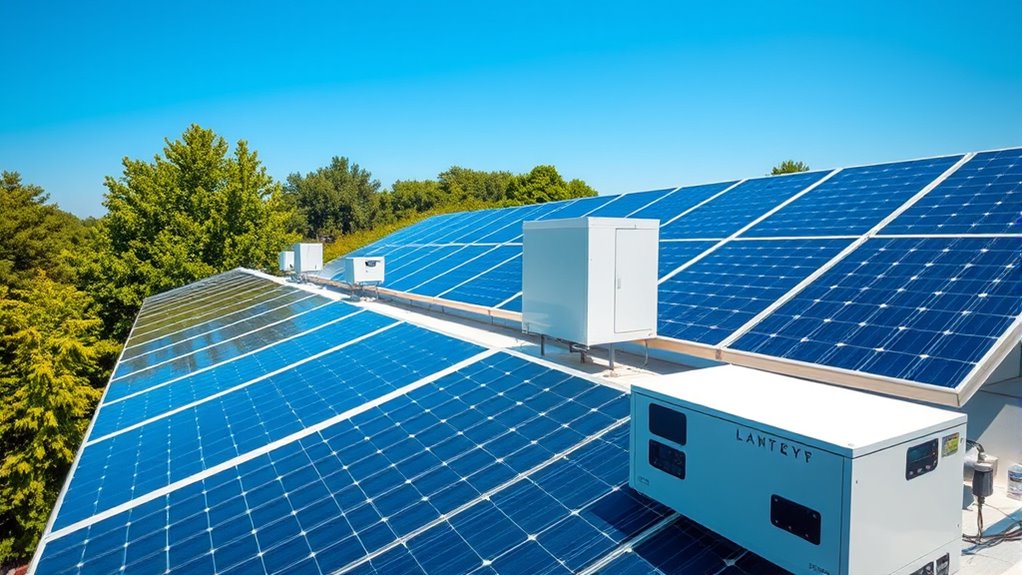To integrate battery storage with your rooftop solar system, start by selecting compatible lithium-ion batteries and ensuring your inverter supports energy storage. Work with qualified installers to set up the hardware and configure system settings for ideal operation, like using stored energy during peak hours. Make sure your system communicates effectively with the grid and complies with local policies. Continue exploring for detailed steps to create a smarter, more efficient energy setup.
Key Takeaways
- Choose a compatible lithium-ion battery system and ensure inverter compatibility for seamless integration.
- Work with qualified installers to properly set up hardware and configure system software.
- Program the system to prioritize drawing from batteries during peak hours and feed excess energy back to the grid.
- Verify local regulations, utility policies, and incentives to ensure compliance and maximize benefits.
- Optimize system operation with smart controls and stay informed about emerging technologies for improved efficiency.

Integrating battery storage with rooftop solar systems offers a practical way to maximize your renewable energy use and reduce reliance on the grid. When you add energy storage to your solar setup, you can capture excess sunlight during the day and store it for later use, such as in the evening or on cloudy days. This not only helps you save on electricity bills but also provides backup power during outages. To achieve seamless grid integration, you’ll need to guarantee your system communicates effectively with the utility grid, allowing for bidirectional flow of energy. This means your batteries can supply power to your home or send excess energy back to the grid, depending on demand and supply.
The first step involves selecting the right energy storage solution. Lithium-ion batteries are popular because of their high efficiency, long lifespan, and declining costs. When choosing a battery system, consider its capacity, power output, and compatibility with your existing solar inverter. Many modern inverters come with integrated battery management systems that simplify installation and optimize performance, ensuring your system works smoothly with grid integration. You also need to evaluate local regulations and utility policies related to energy storage and grid interconnection to guarantee compliance and take advantage of potential incentives.
Once you’ve chosen your storage system, you’ll need to work with a qualified installer to set up the hardware and configure the software for ideal operation. This includes programming the system to prioritize using stored energy during peak hours and to feed excess back into the grid when appropriate. Proper system management is vital for maximizing energy storage benefits and preventing issues like overcharging or discharging batteries prematurely. Additionally, understanding your utility’s net metering policies and time-of-use rates helps you develop a strategy for when to draw from your batteries versus when to rely on grid power. With effective grid integration, your system can automatically switch between stored energy, grid power, and solar generation, providing a reliable and efficient energy supply.
Furthermore, staying informed about emerging AI trends on Instagram and other innovative technologies can help you optimize your energy management system for greater efficiency and sustainability. By carefully planning your system’s design and ensuring proper setup, you’ll be able to maximize your solar investment, increase your energy independence, and contribute to a greener future. Integrating battery storage isn’t just about adding hardware; it’s about creating a smart, responsive energy system that works harmoniously with the grid and your lifestyle.
Frequently Asked Questions
What Is the Lifespan of a Typical Solar Battery?
A typical solar battery lasts about 5 to 15 years, depending on its battery chemistry and storage maintenance. Lithium-ion batteries usually have a lifespan of 10 to 15 years, while lead-acid batteries might last around 5 to 7 years. To maximize your battery’s life, you should perform regular storage maintenance, such as monitoring temperature, avoiding deep discharges, and keeping the system well-managed. Proper care extends your battery’s efficient performance over the years.
How Much Does Battery Storage Installation Cost?
You can expect to pay between $5,000 and $15,000 for a battery storage installation, depending on your desired storage capacity and battery chemistry. Larger systems with higher capacity cost more but provide more backup power. Lithium-ion batteries are popular due to their efficiency and lifespan, while other chemistries might be more affordable but less durable. Always consider your energy needs and storage goals when choosing the right system for your rooftop solar setup.
Are There Government Incentives for Solar-Plus-Storage?
Think of government incentives as a lighthouse guiding your solar journey through financial storms. Yes, there are policy incentives for solar-plus-storage that can lighten your load, making the switch more affordable. These incentives often include tax credits, rebates, and grants, boosting your financial benefits. By taking advantage of them, you can maximize your investment, cut costs, and enjoy a brighter, more sustainable energy future with less financial worry.
Can Battery Storage Work During Power Outages?
Yes, your battery storage can work during power outages, providing emergency backup when grid power fails. To guarantee reliable operation, regularly perform battery maintenance and monitor its health. Keep in mind that some systems may require specific configurations or additional equipment for seamless backup. With proper setup and upkeep, your battery storage keeps essential appliances running, giving you peace of mind during unexpected outages.
How Does Battery Capacity Affect System Performance?
Think of your battery as a reservoir; its capacity determines how much energy it can hold and deliver. Larger capacity boosts system performance, giving you more backup power and savings. However, over time, battery degradation can reduce capacity, so capacity optimization is key to maintaining efficiency. If your battery’s capacity is too small, you might miss out on stored energy, but if it’s too large, it could be unnecessary and costly.
Conclusion
Now that you know how to integrate battery storage with your rooftop solar system, you’re like the hero in your own energy story—powerful and self-sufficient. Just as Prometheus brought fire to mankind, you’re bringing sustainable energy into your home, lighting the way for a greener future. With this knowledge, you can confidently harness the sun’s power and store it for when you need it most. The future of clean energy is in your hands—seize it.









